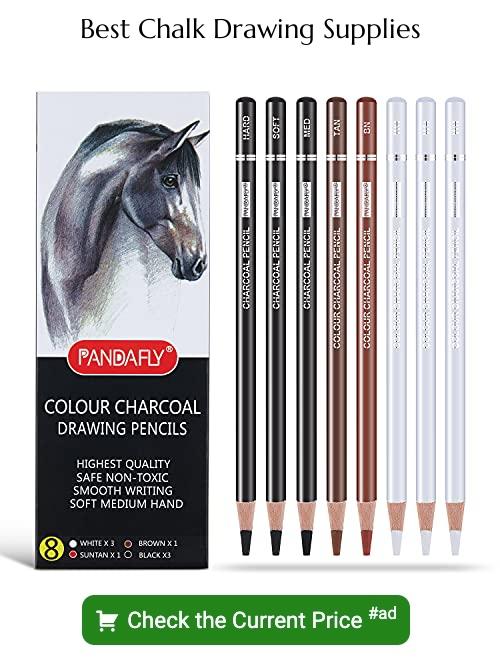Last updated on
This tutorial details an easy-to-follow guide on how to execute stunning artwork using chalk on paper, covering materials, techniques, and tips for preservation.
Key takeaways:
- Choose the right paper for chalk drawing: textured and durable.
- Different types of chalk for paper: soft pastels, compressed pastels, oil pastels, chalk markers.
- Basic chalk drawing techniques: vary pressure, smudging, layering, utilize negative space.
- Protecting and preserving chalk art: fixative spray, hairspray alternative, framing, proper storage, handle with care.
- Inspirational ideas for chalk art: landscapes, portraits, abstract art, practical uses.
Choosing the Right Paper for Chalk Drawing
Selecting the ideal surface is crucial when creating art with chalk on paper. Opt for heavier weights that can withstand the pressure of application and blending. Textured paper with a bit of grit is especially favorable as it grips the chalk, allowing for richer color laydown and better pigment retention.
Construction paper, for instance, is an affordable option that adds a unique texture to your artwork. For artists seeking a longer-lasting piece, acid-free paper is a wise choice due to its durability and resistance to yellowing over time. Consider investing in high-quality artist-grade pastel paper if you’re working on a special project, as it comes in a variety of textures and colors to suit any style.
Remember, the tooth of the paper—its surface texture—can significantly affect the outcome of your art, providing either a smooth finish or a more rustic, grainy appearance depending on your preference and technique.
Different Types of Chalk for Paper
Soft pastels are a popular choice for their vibrant color and smooth texture, blending easily for gradient effects. Compressed chalk pastels offer higher density and less dust, making them ideal for detailed work.
For those seeking a dust-free option, oil pastels can be used on paper to create a creamy, paint-like finish.
However, traditional sidewalk chalk can be too coarse for paper and might damage the surface. Alternatively, chalk markers provide the look of chalk without the mess and are well-suited for creating sharp lines and text on paper.
Always test chalk on a small area of your chosen paper to assess compatibility and prevent unwanted smudging or tearing.
Basic Chalk Drawing Techniques On Paper
Explore the diverse range of strokes you can make with chalk by applying different levels of pressure. Gentle strokes create soft, faint lines, while firmer pressure yields bold, intense marks. Experiment to find the right balance.
Embrace smudging as a technique to create gradient effects or smooth transitions between colors. Use your finger, a piece of fabric, or a blending stump to guide the chalk across the paper surface.
Layering is your friend when working with chalk. Start with lighter colors and gradually add darker shades to add depth and dimension to your artwork. Remember, chalk can be quite forgiving, so build up your layers until you achieve the desired result.
Take advantage of negative space by leaving areas of the paper untouched. This can help define shapes and bring contrast to your composition.
Implementing these techniques will enhance your creations, imbuing them with texture, depth, and a dynamic quality that chalk is uniquely capable of producing.
Protecting and Preserving Chalk Art On Paper
To extend the lifespan of your chalk masterpiece and keep the colors vibrant, consider the following steps:
- Fixative Spray: After completing your artwork, use a fixative spray specifically designed for chalk or pastel art. This will prevent smudging and dusting off. Ensure you spray evenly and lightly to avoid saturating the paper which could lead to color alterations.
- Hairspray Alternative: In a pinch, clear hairspray can serve as a makeshift fixative. Use minimally as it may yellow over time.
- Framing: Placing the artwork under glass immediately after spraying and drying helps protect it from the elements and touch. Use a matte spacer to prevent the chalk from transferring to the glass.
- Proper Storage: If not displaying, store the artwork flat in a cool, dry place. Use wax paper to cover the surface before stacking to prevent smudging.
- Handling with Care: Always handle your chalk art by the edges or with clean, dry hands to avoid fingerprints or smudging the delicate surface.
By following these tips, you ensure your chalk art retains its original beauty and vigor for years to come.
Inspirational Ideas for Chalk Art On Paper
Transform simple paper into a canvas for vibrant murals with a few strokes of chalk. Explore landscapes with a blend of soft pastels, creating scenes from rolling hills to serene lakesides.
Dive into portrait work, experimenting with light and shadow to capture the complexity of facial expressions. For the abstract enthusiast, layer and blend colors to create striking geometric patterns or whimsical swirls that play with the imagination.
Introduce the practical world into art by sketching out weekly menus or to-do lists with a touch of artistic flair, perfect for hanging on the refrigerator or keeping on your desk. Holiday artwork is also a hit; craft handmade greeting cards with personalized chalk drawings for a unique touch that friends and family will cherish.
Remember, the versatility of chalk on paper means the boundaries are as wide as your creativity – from celestial starry nights to the subtle gradations of a sunrise.
FAQ
What is chalk art called?
Chalk art is commonly referred to as pavement art, sidewalk art, street painting, 3-D chalk art, 3-D pavement art, or anamorphic street painting.
Why is drawing with chalk good for children?
Drawing with chalk is beneficial for children as it stimulates their creativity, boosts their fine motor skills, encourages outdoor play, and augments learning by making it interactive and engaging, while also enhancing their confidence and granting them a sense of accomplishment.
How do you keep chalk from smudging on paper?
To prevent chalk from smudging on paper, you can seal it with Krylon Preserve It and allow it to dry for as long as possible.
What type of paper is best for chalk drawing?
Heavyweight, textured paper with a high rag content, such as pastel paper or watercolor paper, is ideal for chalk drawing.
Is it possible to erase chalk art, if needed?
Yes, chalk art can be erased by using a clean, damp cloth or sponge.
Can I blend colors in chalk art as I would with paint?
Yes, you can blend colors in chalk art similar to how you blend with paint.
Recap:





